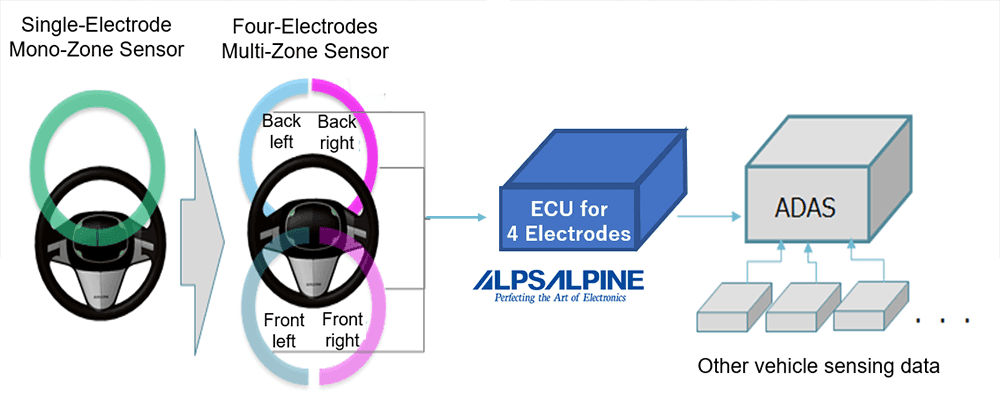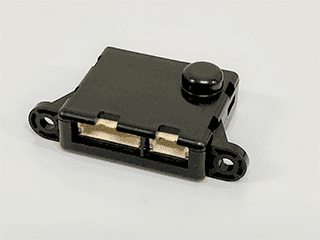News
Four-Electrode Multi-Zone Configuration Distinguishes Between Driver Grip Variations for Safer Mobility
Alps Alpine Develops, Begins Mass Production of Hands-Off Detection ECU for Autonomous Driving Assistance Systems
Information listed here is shown as of the date of release. Please note that production, sales and programs may be terminated or contents such as specifications and prices may be modified by the time you read this information.
Jul 8, 2021
Alps Alpine Co., Ltd. (TSE: 6770; President & CEO: Toshihiro Kuriyama) has developed an electronic control unit (ECU)1 for hands-off detection to support autonomous driving systems by distinguishing between variations in a driver’s grip on the steering wheel. Mass production began in spring 2021 and the plan is to gradually expand deployment to a range of vehicle models. To accommodate advancements in autonomous driving support and further contribute to safe and comfortable mobility, development for next-generation models is already underway.
Background to the Development
Technological innovation is gathering speed within the automotive CASE domains of connected cars, autonomous driving, sharing and services, and electrification. In the field of autonomous driving, we see growing deployment of systems that enable a vehicle, under certain conditions, to automatically follow the car in front while keeping to the lane. One recently developed advanced autonomous driving assistance system now on the market performs all driving tasks under limited scenarios, such as while traveling on an expressway or at low speeds.
Vehicles equipped with these features need to be able to detect and assess a driver’s driving status to allow safe and smooth switching between automated and manual driving. One aspect is hands-off detection, a function for determining the status of the driver’s grip on the steering wheel that interacts with other systems for assessing driving status to enable safe switching between driver-controlled and system-controlled modes. Safety features are necessary given the ongoing sophistication of autonomous driving assistance systems, and legislation is progressing. Provisions under the R79 international regulation are one example.
Determining the right time to switch between autonomous driving assistance and manual driving requires constant monitoring of the vehicle’s drive status and the driver’s driving posture to ensure safety. If the continuation of autonomous driving assistance is deemed inappropriate, the driver needs to be quickly warned that the assistance is to be disengaged and urged to immediately revert to manual driving. Safety assurances demand much more precise detection of diverse variations of the driver’s grip on the steering wheel.
Outline of the Development
1. System Configuration
Capacitive sensing is the
dominant technology used for steering wheel touch detection due to its cost
and functional performance. The ECU uses data obtained via a special-purpose
capacitive sensor, wrapped around the steering wheel, to determine if the
driver is touching it and conveys the assessment to an advanced driver
assistance system (ADAS). Whereas existing hands-off detection systems are
mono-zone setups, with a single electrode, Alps Alpine has developed a
multi-zone configuration with four electrodes (see Fig. 1). Dividing the
steering wheel and grip patterns into smaller sections enables efficient
system switching and enhanced touch assessment reliability.

Fig.1

2. Product Outline
Resilience to physical stress is a
necessary consideration when employing capacitive control, as is the need to
maintain resistance to environmental factors – temperature, humidity and
electromagnetic noise – and the feel of the sensor itself. It is also
essential to have separate, optimal control for sensor materials specific to
the application. Alps Alpine started producing touch panels for notebook PCs
and game consoles in the 1990s and automotive control panels for capacitive
touch-type in-vehicle infotainment (IVI) systems in the 2010s. The company
has plenty of experience applying capacitive control technology to a diverse
range of sensor materials and environments spanning product domains from
consumer electronics to automobiles. Utilizing this knowledge, we have
developed a hands-off detection ECU for use with a special-purpose steering
wheel capacitive sensor. Deliveries to steering wheel manufacturers began in
spring 2021.
1)
Industry-first four-electrode sensor (see Fig. 1)
The sensor
electrode is divided into four sections to enable identification of
various grip states. This allows a more detailed assessment of driving
status than a basic touching/not touching determination reached using an
existing single-electrode sensor.
2)
Original capacitive control ASIC2
Alps Alpine has
developed an original capacitive control ASIC with improved durability and
versatility for conformance to strict automotive standards.
3)
Optimal algorithms for different applications
Steering wheel design,
sensor material, electromagnetic compatibility3…conditions vary
from model to model, leading to variance in data obtained via the
capacitive sensor. To accommodate the separate circumstances, Alps Alpine
can supply an originally developed algorithm that seeks individual
optimization, for example with parameter changes.
4)
Failure self-diagnosis function
Reliability is enhanced by an
original failure determination feature and the product conforms to ISO
26262, the international standard on the functional safety of electrical
and electronic systems in automobiles.
Outlook
By fiscal 2025, we can expect further advancements among autonomous driving assistance features and needs for hands-off detection are predicted to grow all over the world. The success of this product’s development forms a base on which to approach automobile and steering wheel manufacturers with product proposals and expand sales. Alps Alpine will also put forward product proposals, representing examples of applied capacitive technology, for a wide range of human-machine interfaces (HMI) both inside and outside the vehicle cabin, not just hands-off detection. This is part of our contribution to safe and comfortable automobile-based mobility.
【Planned Release】
| Mass Production | From spring 2021 |
| Monthly output | 40,000 units (2022) |
| Development | Furukawa R&D Center (Osaki, Miyagi Pref.) |
| Production | Furukawa Plant 2 (Osaki, Miyagi Pref.) |
【Specifications】
| Model | ECU for Hands-Off Detection |
| Dimensions (W×D×H) | 40 × 45 × 12mm (ref.) |
| Interface | LIN 2.1 or 2.2 |
| Operating voltage/current | 8-16V/Up to 100mA |
| Guaranteed operating temperature range | -40°C to +85°C |